Proper temperature control is crucial for grocery stores to maintain the quality of their products and ensure customer satisfaction. Grocery store temperature, climate control, and HVAC systems play a significant role in creating a comfortable shopping environment and preserving the freshness and safety of perishable goods.
In this article, we will explore the ideal temperatures for different areas in a grocery store and discuss the importance of temperature monitoring and food safety guidelines in ensuring the highest standards of quality and safety.
Table of Contents
Key Takeaways:
- Proper temperature control in grocery stores is essential for maintaining product quality.
- Grocery stores must adhere to specific climate control standards to keep food products fresh and safe.
- Temperature monitoring devices, like those offered by SensoScientific, provide accurate measurements for effective temperature management.
- Following the 7 principles of food safety helps prevent cross-contamination and ensures the safety of food products.
- Maintaining optimal temperature control in grocery stores creates a safe and comfortable environment for customers.
Importance of Food Safety in Grocery Stores
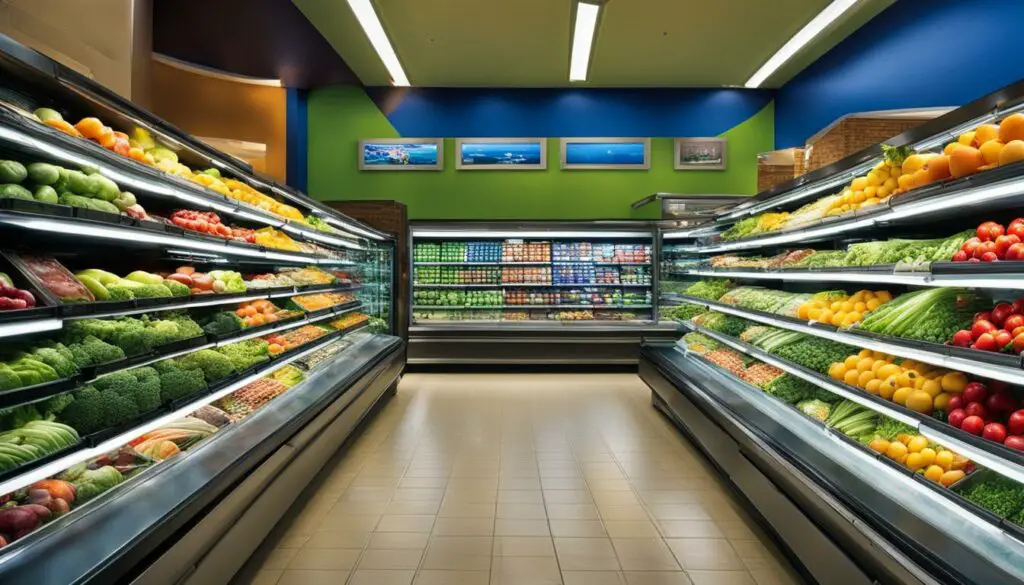
Food safety is a critical concern in grocery stores as improper handling and storage of food can lead to contamination and foodborne illnesses. The safety and well-being of consumers should always be a top priority for any grocery store.
Food can become compromised in various ways, whether through physical, chemical, or biological substances. One of the most common causes of foodborne illnesses is the presence of bacteria. Some of the most well-known bacteria associated with foodborne illnesses include Salmonella, E. Coli, and Listeria.
Cross-contamination is another significant risk factor in grocery stores. When different types of food come into contact with each other, bacteria can transfer and contaminate otherwise safe products.
Proper temperature control is a key aspect of food safety in grocery stores. Maintaining the right temperature helps prevent the growth of bacteria and ensures the safety of the food products sold to customers.
“One of the most important aspects of food safety is maintaining the proper temperature in grocery stores. Temperature control is essential for preventing foodborne illnesses and ensuring the quality of the products.”
By adhering to food safety guidelines and implementing strict temperature control measures, grocery stores can significantly reduce the risk of contamination and protect the health of their customers.
The Danger Zone and Its Impact on Food Safety
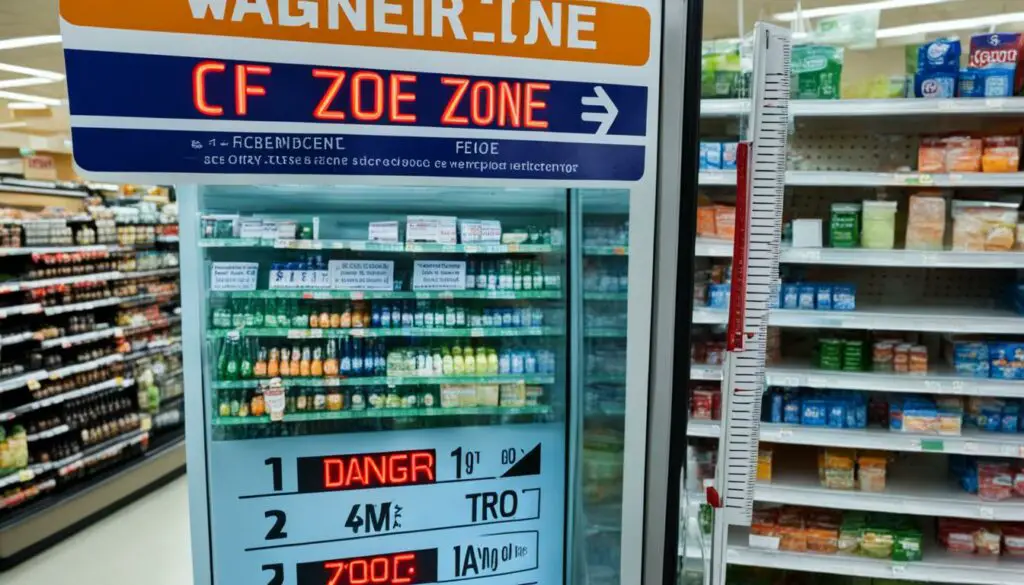
When it comes to food safety, understanding the concept of the danger zone is crucial. The danger zone refers to the temperature range in which bacteria can rapidly multiply in food. Maintaining proper temperature control is essential to prevent bacteria growth and safeguard the health of consumers.
In the danger zone, which spans from 41 to 135 degrees Fahrenheit, bacteria can multiply at alarming rates. It’s important to note that this temperature range is especially favorable for bacteria growth, posing a significant risk to food safety. Cold foods should be stored below this range, while hot foods should be kept above it to inhibit bacterial proliferation.
Effective temperature monitoring plays a critical role in reducing the amount of time food spends in the danger zone. By closely monitoring temperatures, food service establishments can ensure that perishable items are stored at safe temperatures and minimize the risk of food contamination.
Proper temperature monitoring involves the use of accurate and reliable temperature monitoring devices. These devices help detect and alert when the temperature deviates from the optimal range, enabling timely corrective actions. Regular temperature checks and monitoring systems are essential components of a robust food safety program.
The Importance of Temperature Monitoring
“Temperature monitoring is essential to minimize the risk of bacterial growth and foodborne illnesses in grocery stores.”
Temperature monitoring not only helps prevent bacterial growth but also contributes to overall food safety management. By consistently monitoring temperatures in storage areas, such as refrigerators, freezers, and display cases, grocery stores can ensure that perishable items are stored in the optimal conditions until they reach the consumers’ tables.
Unmonitored temperature fluctuations can render food susceptible to contamination, compromised quality, and ultimately consumer dissatisfaction. By implementing an effective temperature monitoring system, grocery stores can stay proactive in identifying and resolving temperature-related issues promptly.
Temperature monitoring devices, such as data loggers and temperature probes, enable continuous monitoring and accurate measurement of temperature conditions. These devices provide real-time temperature data, helping store managers and staff make informed decisions to maintain food safety standards.
By preventing food from spending extended periods in the danger zone, temperature monitoring significantly reduces the risk of bacterial growth and foodborne illnesses. It also contributes to longer product shelf life and ensures that customers can purchase and consume high-quality and safe food products.
The Role of Employees in Temperature Monitoring
While temperature monitoring devices are integral to food safety management, the responsibility extends to well-trained and knowledgeable employees. Employees should be educated on the importance of accurate temperature monitoring and the potential consequences of neglecting proper temperature control.
Employees should regularly check and record temperatures, promptly address any deviations, and report any issues to the appropriate personnel. By actively participating in temperature monitoring efforts, employees play a vital role in maintaining a safe and sanitary environment for food storage and handling.
Preventing Bacterial Growth: Best Practices
To minimize bacterial growth and ensure food safety, grocery stores should implement the following best practices:
- Regularly calibrate temperature monitoring devices to ensure accuracy.
- Monitor temperatures at multiple points throughout storage areas.
- Establish temperature monitoring protocols and train employees accordingly.
- Document temperature records and retain them for future reference.
- Take immediate corrective actions when temperature deviations occur.
- Implement a thorough cleaning and sanitation schedule to prevent cross-contamination.
By adhering to these practices, grocery stores can effectively minimize bacterial growth, reduce the risk of foodborne illnesses, and maintain the highest standards of food safety.
Ideal Temperature for Refrigerated Storage
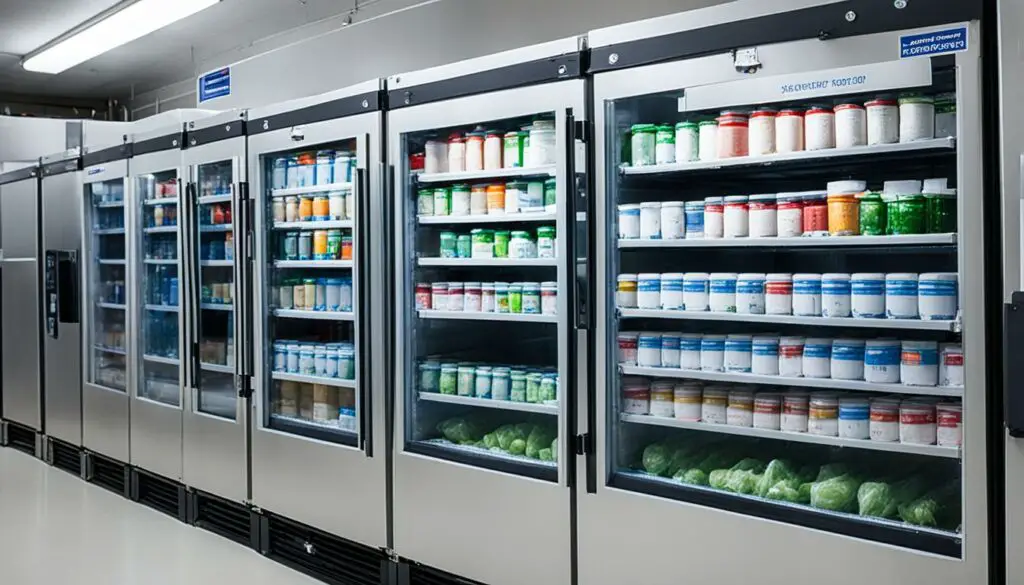
Refrigerated storage plays a crucial role in maintaining the freshness and safety of perishable food items. It is essential to store these goods at the correct temperature to slow down bacterial growth and preserve their quality. According to food safety guidelines, the ideal temperature range for refrigerated storage is between 32 and 40 degrees Fahrenheit.
By keeping perishable food items within this temperature range, you can significantly reduce the risk of foodborne illnesses caused by bacterial contamination. This controlled environment helps to extend the shelf life of products and maintain their nutritional value.
Proper temperature monitoring is key to ensuring that the refrigerated storage remains within the recommended range. By utilizing data loggers and temperature probes, grocery stores can accurately measure and maintain the desired temperature levels. These devices provide real-time monitoring and alert store personnel if there are any deviations from the optimal temperature range.
Here is a table that highlights the importance of refrigerated storage and the corresponding recommended temperature range for different food products:
| Food Product | Ideal Refrigerator Temperature (Fahrenheit) |
|---|---|
| Dairy Products | 36-40 |
| Fruits and Vegetables | 32-40 |
| Meat and Poultry | 32-40 |
| Seafood | 32-40 |
| Ready-to-Eat Foods | 32-40 |
It’s important to note that refrigerated storage areas should be regularly cleaned and organized to prevent cross-contamination and maintain proper airflow. Additionally, frequent temperature checks and calibration of monitoring devices are necessary to ensure the accuracy of temperature readings.
By following these guidelines and monitoring the temperature of refrigerated storage diligently, grocery stores can uphold food safety standards and provide customers with fresh and high-quality products.
Ideal Temperature for Frozen Storage
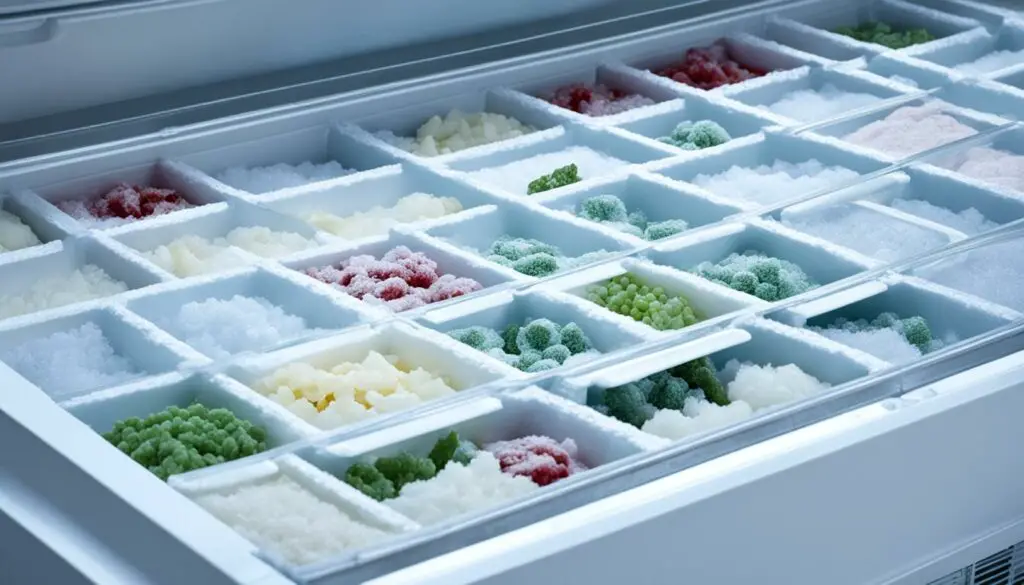
When it comes to frozen storage, maintaining the ideal temperature is crucial for preserving the quality and safety of frozen food products. Freezing food not only helps prolong its shelf life but also prevents bacterial growth. The recommended temperature for freezer storage is below 0 degrees Fahrenheit.
By storing frozen goods at this temperature, you can ensure that they remain safe for consumption and retain their nutritional value. It’s important to note that a consistent freezer temperature is essential to prevent thawing and refreezing, which can compromise the quality of the food.
Benefits of Proper Freezer Temperature
Achieving and maintaining the proper freezer temperature offers several benefits:
- Preserves freshness: Frozen storage helps preserve the freshness of food items by slowing down the deterioration process.
- Prevents bacterial growth: Freezing food at temperatures below 0 degrees Fahrenheit prevents the growth of bacteria and other pathogens that can cause foodborne illnesses.
- Retains nutritional value: Properly frozen food retains its nutritional content, providing consumers with healthy and wholesome options.
To visually illustrate the impact of freezer temperature on food safety, the table below showcases the recommended freezing temperatures for different types of food:
| Food Item | Recommended Freezer Temperature |
|---|---|
| Frozen Meats | Below 0 degrees Fahrenheit |
| Frozen Vegetables | Below 0 degrees Fahrenheit |
| Frozen Seafood | Below 0 degrees Fahrenheit |
| Ice Cream | Between -5 and 0 degrees Fahrenheit |
Proper temperature control in freezer storage areas is essential to maintain the quality and safety of frozen food products.
By following the recommended temperature guidelines, you can ensure that your frozen food products remain safe, delicious, and ready to be enjoyed at any time. It is crucial to regularly monitor the freezer temperature and address any deviations promptly to maintain optimal food safety.
Ideal Temperature for Dry Goods Storage
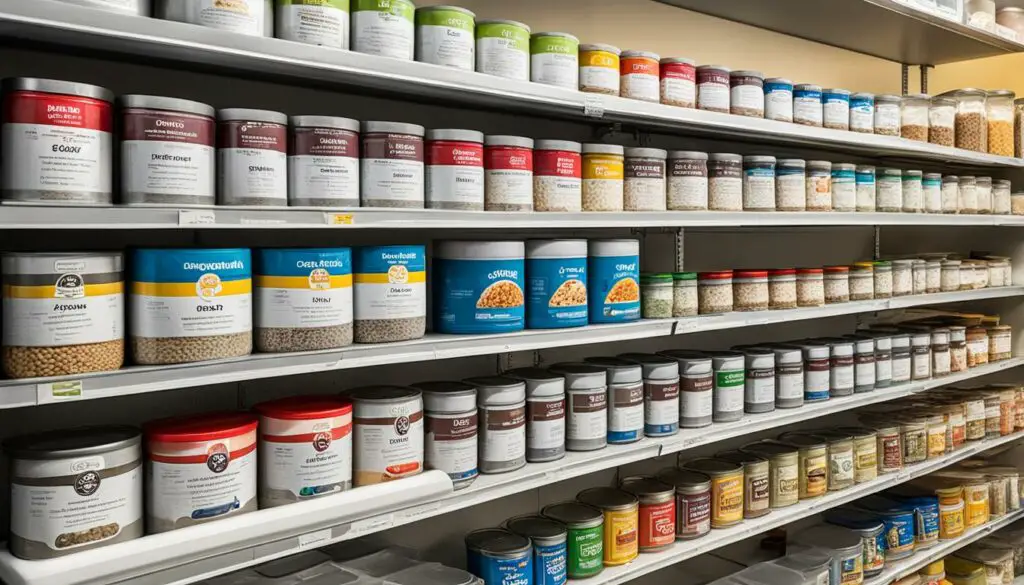
Dry goods, including packaged foods and non-perishable items, should be stored at temperatures typically ranging from 50 to 70 degrees Fahrenheit. While the temperature requirements for dry storage are not as strict as for refrigerated or frozen storage, maintaining a consistent temperature helps preserve the quality and integrity of dry goods.
Unlike perishable foods, dry goods are not as susceptible to bacterial growth or spoilage. However, fluctuations in temperature can still impact the overall quality and shelf life of these products. Storing dry goods in an environment with a controlled temperature ensures that they remain fresh, flavorful, and safe to consume.
Exposure to extreme heat or cold can cause dry goods to deteriorate faster, leading to changes in texture, taste, and nutritional value. For example, high temperatures can cause spices to lose their potency, while low temperatures can make certain ingredients more susceptible to moisture absorption.
It’s important to note that specific dry goods may have different temperature requirements. For example, chocolates and candies may benefit from slightly lower temperatures, while certain types of grains may be best stored at slightly higher temperatures.
To maintain optimal dry goods storage conditions, consider the following tips:
- Store dry goods in a cool, dry location away from direct sunlight and heat sources.
- Avoid storing dry goods near appliances that generate heat, such as ovens or refrigerators.
- Ensure proper airflow to prevent the accumulation of moisture or humidity.
- Monitor and maintain temperature levels within the recommended range.
- Regularly inspect dry goods for signs of spoilage, including pest infestations, off odors, or changes in texture.
By following these guidelines, you can extend the shelf life of your dry goods and ensure they remain in optimal condition for consumption.
| Dry Goods | Recommended Storage Temperature |
|---|---|
| Packaged Foods | 50-70°F |
| Spices | 50-60°F |
| Grains | 60-70°F |
Importance of Temperature Monitoring in Grocery Stores
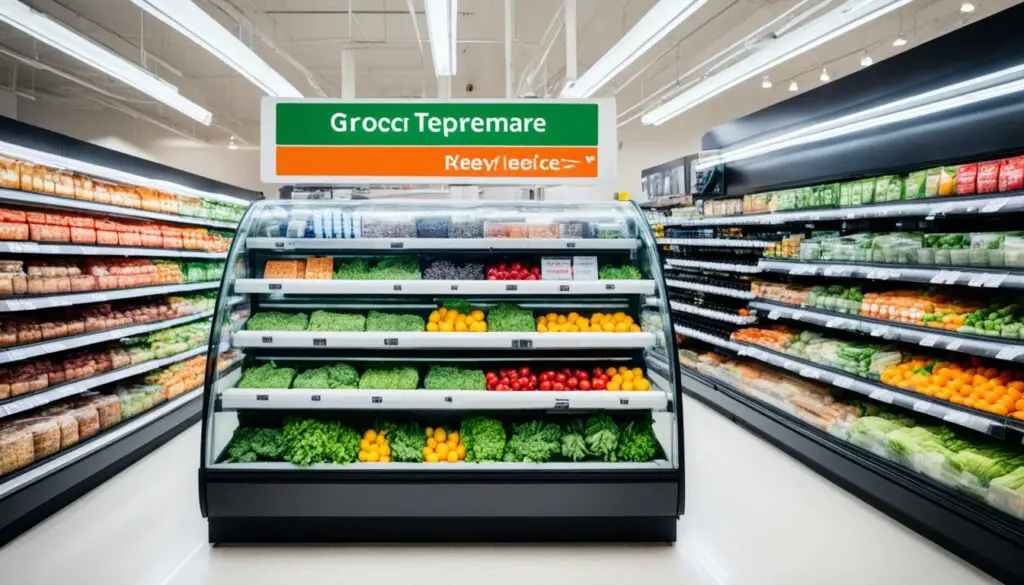
When it comes to ensuring food safety in grocery stores, temperature monitoring takes center stage. The right temperature is crucial for preserving the freshness and quality of food products. This is why data loggers and temperature probes are widely used to monitor and record temperatures in storage areas. They provide valuable insights that help maintain the proper temperature range and prevent any deviations that could compromise the safety of the stored items.
With temperature monitoring devices in place, grocery store owners can effectively track and control the temperature conditions of their storage areas. This allows them to identify and address any issues in real-time, ensuring that food products are stored at the optimal temperature range.
Why Temperature Monitoring Matters
“Temperature monitoring is critical in the grocery industry. It helps us safeguard the quality and integrity of our products. With accurate temperature data, we can confidently deliver fresh and safe food to our customers.”
– Anna Smith, Store Manager at Fresh Mart
Temperature monitoring devices serve as early warning systems. They are equipped with alarms that alert store owners and staff when temperature violations occur. This allows for immediate action to be taken, preventing any potential damage to food products due to improper storage conditions.
Moreover, temperature monitoring plays a key role in ensuring compliance with food safety regulations, such as those set by the Hazard Analysis Critical Control Point (HACCP) management system. By integrating temperature monitoring into their HACCP protocols, grocery stores can demonstrate their commitment to providing safe and high-quality food to consumers.
The Benefits of Temperature Monitoring in Grocery Stores
Implementing a robust temperature monitoring system brings several benefits to grocery stores:
- Enhanced food safety: With accurate temperature data, grocery stores can prevent bacterial growth and minimize the risk of foodborne illnesses.
- Product quality preservation: Maintaining the proper temperature range helps preserve the freshness, taste, and nutritional value of food products.
- Reduction in product waste: By closely monitoring temperatures, grocery store owners can avoid temperature fluctuations that could lead to spoilage and wastage of perishable items.
- Compliance and peace of mind: Temperature monitoring ensures adherence to food safety regulations and provides store owners with confidence in the quality of their products.
Ensuring Accuracy and Ease of Use in Temperature Monitoring Devices
To achieve accurate temperature monitoring in grocery stores, it is crucial to utilize reliable and properly calibrated devices. The integrity of temperature measurements is essential for maintaining food safety and quality. Malfunctioning or inaccurate temperature monitoring devices can lead to incorrect readings, potentially compromising the safety of food products.
That’s why it is important to choose user-friendly devices that provide accurate and precise temperature measurements. When it comes to temperature monitoring solutions, one brand stands out: SensoScientific. Their innovative devices are designed with both accuracy and ease of use in mind, making them an ideal choice for effective temperature monitoring in grocery stores.
Why SensoScientific?
SensoScientific offers a range of temperature monitoring devices that are specifically tailored to meet the needs of the food industry. Their devices are equipped with advanced sensors and technology, ensuring accurate temperature measurements that can be relied upon.
Additionally, SensoScientific devices are designed with user-friendliness in mind. They feature intuitive interfaces and simple navigation, making them easy to set up and use. The devices also provide real-time monitoring and alerts, allowing store managers and staff to take immediate action if any temperature deviations occur.
“We chose SensoScientific’s temperature monitoring system for our grocery store, and it has been a game-changer. The devices are incredibly accurate, and the user interface is simple and intuitive. With real-time monitoring and alerts, we can address any temperature issues promptly, ensuring the safety of our products and the satisfaction of our customers.” – Jane Smith, Grocery Store Owner
By choosing SensoScientific as your temperature monitoring partner, you can have peace of mind knowing that accurate temperature measurements and ease of use are the top priorities. With their reliable devices, you can effectively monitor and maintain optimal temperature conditions in your grocery store, ensuring the safety and quality of your food products.
Don’t compromise on accuracy and ease of use when it comes to temperature monitoring. Choose SensoScientific and experience the difference it can make for your grocery store.
The 7 Principles of Food Safety and Temperature Control
Proper temperature control in grocery stores is vital for ensuring the safety and quality of the food products sold. By following the 7 principles of food safety, grocery stores can maintain HACCP compliance and prevent foodborne illnesses related to temperature misuse. These principles include:
- Cleanliness: Maintaining a clean and sanitized environment is essential to prevent the growth of harmful bacteria. Regular cleaning of storage areas, equipment, and utensils helps eliminate potential sources of contamination.
- Separation of Different Food Types: Properly storing and segregating different food types reduces the risk of cross-contamination. Raw meats, seafood, and poultry should be stored separately from ready-to-eat foods to prevent the transfer of harmful bacteria.
- Proper Cooking Temperatures: Cooking food to the correct internal temperature ensures the destruction of harmful bacteria. Using calibrated thermometers and following recommended cooking temperatures for different types of food is crucial for food safety.
- Proper Chilling and Storage Practices: Cooling and storing food at the appropriate temperatures prevents the growth of bacteria. Hot foods should be cooled rapidly and refrigerated promptly. Perishable foods should be stored at the correct temperature to maintain their quality and safety.
- Hygienic Food Handling: Following proper hygiene practices, such as washing hands regularly, using clean utensils, and wearing gloves, reduces the risk of food contamination. Food handlers should receive training on safe food handling practices.
- Safe Water and Raw Materials: Using clean and safe water for food preparation and ensuring the quality of raw materials is essential for food safety. Regular testing of water sources and conducting quality checks on raw materials helps prevent contamination.
- Implementing HACCP Principles: The Hazard Analysis Critical Control Point (HACCP) system is a preventive approach to food safety. It involves identifying and controlling potential hazards at critical points in the food production process. Compliance with HACCP guidelines helps ensure the safety and quality of food products.
By adhering to these principles, grocery stores can maintain optimal temperature control, minimize the risk of foodborne illnesses, and provide safe and high-quality food products to their customers.
References:
- Food Safety and Inspection Service. (2021). Cleanliness Helps Prevent Foodborne Illness. USDA Food Safety and Inspection Service.
- Centers for Disease Control and Prevention. (2021). Principles of HACCP.
- Food and Drug Administration. (2021). Food Code.
Conclusion
Maintaining optimal temperature control in grocery stores is crucial for preserving food quality and ensuring the safety of customers. Through proper temperature monitoring, adherence to food safety guidelines, and the use of reliable temperature monitoring devices, grocery stores can create a safe and comfortable environment while upholding the highest standards of food safety.
By keeping temperatures within the recommended ranges for refrigerated, frozen, and dry storage, grocery stores can slow down bacterial growth, minimize the risk of food contamination, and maintain the freshness and integrity of their products. Temperature monitoring devices, such as those provided by SensoScientific, offer accurate readings and user-friendly interfaces, making it easier for grocery store owners and staff to ensure precise temperature control.
Adhering to the principles of food safety, including proper cleaning practices, separation of different food types, and correct cooking and chilling temperatures, is equally important. Implementing a Hazard Analysis Critical Control Point (HACCP) management system further enhances food safety compliance and ensures that grocery stores meet regulatory standards.
By prioritizing optimal grocery store temperatures, businesses can not only protect their customers from foodborne illnesses but also maintain the freshness, quality, and taste of their products. Creating a safe and trusted shopping environment through proper temperature control is a fundamental aspect of every successful grocery store operation.
FAQ
What is the ideal temperature for a grocery store?
The ideal temperature for a grocery store depends on the specific area within the store. Generally, the temperature should be around 68-72 degrees Fahrenheit in customer areas and 32-40 degrees Fahrenheit in refrigerated storage areas.
Why is food safety important in grocery stores?
Food safety is crucial in grocery stores to prevent foodborne illnesses and ensure the quality and safety of the products sold. Improper handling and storage of food can lead to contamination and the growth of bacteria.
What is the danger zone, and how does it impact food safety?
The danger zone refers to the temperature range between 41 and 135 degrees Fahrenheit. Within this range, bacteria can multiply rapidly in food, increasing the risk of foodborne illnesses. It is important to keep cold food below this range and hot food above it to prevent bacterial growth.
What is the ideal temperature for refrigerated storage in a grocery store?
The ideal temperature for refrigerated storage in a grocery store is between 32 and 40 degrees Fahrenheit. This temperature range helps slow down the growth of bacteria and maintain the freshness and quality of the stored products.
What is the ideal temperature for frozen storage in a grocery store?
The ideal temperature for frozen storage in a grocery store is below 0 degrees Fahrenheit. Freezing food helps preserve its freshness and prevents bacterial growth.
What is the ideal temperature for storing dry goods in a grocery store?
Dry goods, such as packaged foods and non-perishable items, should be stored at temperatures typically ranging from 50 to 70 degrees Fahrenheit. Maintaining a consistent temperature helps preserve the quality and integrity of dry goods.
Why is temperature monitoring important in grocery stores?
Temperature monitoring is crucial in grocery stores to ensure food safety and compliance with regulations. It helps prevent temperature fluctuations that could lead to bacterial growth and spoilage of food products.
What is the importance of accurate and user-friendly temperature monitoring devices?
Accurate and user-friendly temperature monitoring devices are essential as they ensure reliable temperature readings and ease of use for accurate monitoring. Malfunctioning or inaccurate devices can compromise food safety.
What are the 7 principles of food safety and temperature control?
The 7 principles of food safety include cleanliness, separation of different food types, proper cooking temperatures, and proper chilling and storage practices. Adhering to these principles helps prevent cross-contamination and ensures the safety of the food products sold in grocery stores.
What is the conclusion regarding optimal grocery store temperatures?
Maintaining optimal temperature control in grocery stores is crucial for preserving food quality and protecting customers from foodborne illnesses. Proper temperature monitoring, adherence to food safety guidelines, and the use of reliable temperature monitoring devices contribute to ensuring the safety and freshness of food products in grocery stores.
Source Links
- https://www.sensoscientific.com/grocery-temperature-monitoring-how-your-food-is-kept-safe/
- https://hubworks.com/food-safety-temperatures.html
- https://opentextbc.ca/foodsafety/chapter/storage-temperatures-and-procedures/
See also:
Leave a Reply